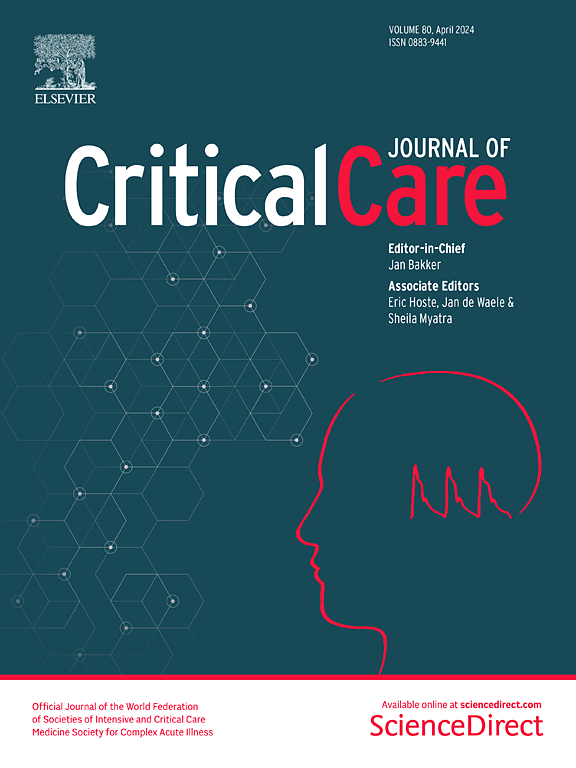简要报告:ICU-RESUS 临床试验中小儿气管插管相关心脏骤停的发生率和结果
IF 8.8
1区 医学
Q1 CRITICAL CARE MEDICINE
引用次数: 0
摘要
气管插管(TI)相关心脏骤停(TI-CA)在儿科 ICU TI 中占 1.7%。我们的目的是评估伴有和不伴有 TI-CA 的心脏骤停患者的复苏特征和结果。对 ICU-RESUS 试验和辅助 CPR-NOVA 研究中的心脏骤停患者进行二次分析。主要暴露是 TI-CA,定义为在 TI 过程中或气管插管后 20 分钟内发生的心跳骤停。主要结果是出院后的存活率和良好的神经系统结果(小儿脑功能分类评分 1-3 分或无变化)。在 315 名心脏骤停患儿中,有 48 名(15.2%)符合 TI-CA 标准。两组患儿发病前的身体状况相似。与非 TI-CA 患者(35/267,13.1%)相比,TI-CA 患者在心跳骤停前进行无创机械通气的比例更高(18/48,37.5%)。48%(23/48)的 TI-CA 发生在插管后 20 分钟内(即插管期间)。TI-CA 患者的心肺复苏持续时间(中位数 11.0 分钟,四分位数间距 [IQR]:2.5, 35.5)长于非 TI-CA 患者(中位数 5.0 分钟,四分位数间距 [IQR]:2.0, 21.0),P = 0.03。32/48(66.7%)名 TI-CA 患者恢复了自主循环,而 186/267 (69.7%)名非 TI-CA 患者恢复了自主循环,P = 0.73。29/48 (60.4%) TI-CA 与 146/267 (54.7%) 非 TI-CA 相比,P = 0.53。在这些儿科 ICU 心脏骤停患者中,15% 与 TI 有关。一半的 TI-CA 发生在气管插管之后。虽然TI-CA患者的心肺复苏持续时间较长,但TI-CA与非TI-CA的未调整结果没有差异。ICU-RESUS(ClinicalTrials.gov Identifier:NCT 02837497)。本文章由计算机程序翻译,如有差异,请以英文原文为准。
Brief report: incidence and outcomes of pediatric tracheal intubation-associated cardiac arrests in the ICU-RESUS clinical trial
Tracheal intubation (TI)-associated cardiac arrest (TI-CA) occurs in 1.7% of pediatric ICU TIs. Our objective was to evaluate resuscitation characteristics and outcomes between cardiac arrest patients with and without TI-CA. Secondary analysis of cardiac arrest patients in both ICU-RESUS trial and ancillary CPR-NOVA study. The primary exposure was TI-CA, defined as cardiac arrest occurred during TI procedure or within 20 min after endotracheal tube placement. The primary outcome was survival to hospital discharge with favorable neurological outcome (Pediatric Cerebral Performance Category score 1–3 or unchanged). Among 315 children with cardiac arrests, 48 (15.2%) met criteria for TI-CA. Pre-existing medical conditions were similar between groups. Pre-arrest non-invasive mechanical ventilation was more common among TI-CA patients (18/48, 37.5%) compared to non-TI-CA patients (35/267, 13.1%). In 48% (23/48), the TI-CA occurred within 20 min after intubation (i.e., not during intubation). Duration of CPR was longer in TI-CA patients (median 11.0 min, interquartile range [IQR]: 2.5, 35.5) than non-TI-CA patients (median 5.0 min, IQR 2.0, 21.0), p = 0.03. Return of spontaneous circulation occurred in 32/48 (66.7%) TI-CA versus 186/267 (69.7%) non-TI-CA, p = 0.73. Survival to hospital discharge with favorable neurological outcome occurred in 29/48 (60.4%) TI-CA versus 146/267 (54.7%) non-TI-CA, p = 0.53. Fifteen percent of these pediatric ICU cardiac arrests were associated with TI. Half of TI-CA occurred after endotracheal tube placement. While duration of CPR was longer in TI-CA patients, there were no differences in unadjusted outcomes following TI-CA versus non-TI-CA. The ICU-RESUS (ClinicalTrials.gov Identifier: NCT 02837497).
求助全文
通过发布文献求助,成功后即可免费获取论文全文。
去求助
来源期刊

Critical Care
医学-危重病医学
CiteScore
20.60
自引率
3.30%
发文量
348
审稿时长
1.5 months
期刊介绍:
Critical Care is an esteemed international medical journal that undergoes a rigorous peer-review process to maintain its high quality standards. Its primary objective is to enhance the healthcare services offered to critically ill patients. To achieve this, the journal focuses on gathering, exchanging, disseminating, and endorsing evidence-based information that is highly relevant to intensivists. By doing so, Critical Care seeks to provide a thorough and inclusive examination of the intensive care field.
 求助内容:
求助内容: 应助结果提醒方式:
应助结果提醒方式:


